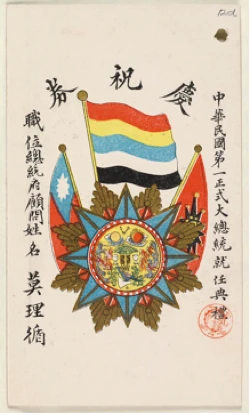
Zoom: 100%
An invitation to president inauguration ceremony, bearing the five-colour flag of the Republic of China
Britain Officially Recognizes the Republic of China
On October 6, 1913, Britain officially recognized the Republic of China, just days before Yuan Shikai's formal inauguration as president. This formal diplomatic recognition, extended by Britain and several other major powers, affirmed the legitimacy of the republican government that had replaced the Qing Dynasty. The Republic had been established on January 1, 1912, following the Xinhai Revolution, which began with the Wuchang Uprising on October 10, 1911. Meanwhile, even after the fall of the Qing, the Constitutional Monarchy League (保皇黨)—supporters of a Qing constitutional monarchy—remained active in overseas Chinese communities, including in Toronto's Chinatown, where they continued to organize political and cultural activities into the 1910s and beyond. This recognition came nearly two decades before Japan created the puppet state of Manchukuo in 1932, installing Puyi, the last Qing emperor, as a symbolic ruler. Britain did not recognize Manchukuo and continued to acknowledge the Republic of China as the legitimate government. Canada, following Britain's lead in foreign policy at the time, also recognized the Republic. However, Canada later diverged from Britain; when the UK recognized the newly established People's Republic of China in 1950, Canada chose not to follow suit. Instead, Canada continued to recognize the ROC government after it relocated to Taiwan in 1949, maintaining this official recognition for two more decades until formally recognizing the PRC in 1970.